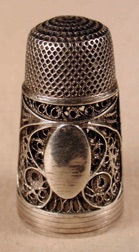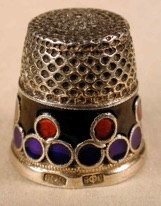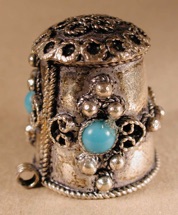More about Thimbles





Magdalena and William Isbister.
Introduction
Recently we successfully bid for a filigree thimble on Ebay. The thimble duly arrived and we were amazed with the fineness of the work and the skill utilized by the maker to craft such a fine piece of ‘art’. We decided to further investigate filigree thimbles, their dates of manufacture and their countries of origin.
History
‘Filigree, a name given to a species of goldsmith's ornamental work fashioned out of fine metallic (usually gold or silver and often twisted) wire into lace-like patterns; the art is of ancient date, and was skillfully practiced by the Etruscans and Egyptians, as well as in Central Asia and India’ (1). The very pure precious metals are drawn into extremely fine threads. These threads are then ingeniously inter-woven to produce almost transparent objects. The art consists of curling, twisting, or plaiting the fine, pliable metal threads and soldering them at their points of contact with each other and, if there is one, with the metal groundwork (filigree appliqué). Very delicate wires were protected by surrounding them with stronger supporting wires. Filigree work should not be confused with ajouré work in which the metal is either punched, drilled or cut out.
Filigree work, now a special branch of the jeweller’s art, was in ancient times, part of the ordinary work of any jeweller. The jewellry of the Etruscans and Greeks (600-300 BC), for example, was made by soldering together and so building up the gold rather than by chiselling or engraving the material (2). Probably as a result of Grecian migration, filigree work came to India and Central Asia. The Saxons, Britons and Celts were very skilled in the art and in Medieval times much of the filigree was associated with religious items. The Moors in Spain were very expert jewellers and from Spain the art of filigree manufacture crossed to the Americas. Chinese filigree found its way to the countries, which traded with China, Portugal and Spain, in the 16th and 17th centuries. Today, filigree jewellry is still made in Italy, Malta, Albania and Greece.
Thimbles
Filigree work pre dates the manufacture of thimbles by many centuries. Christoph Weigel (3), writing in 1698, describes some early German thimbles (Fig 1):
‘’There are also double thimbles with the inner part being completely smooth and gilded, and the outer part which fits snugly over the inner part is made of finely cut and pierced silver and which looks very attractive. They often decorate the lower edge of the thimble by engraving garlands, foliage, animals and the like, in which type of work the craftsmen of Nürnberg remained the leaders because foreigners seldom engage in it.’’

Figure 1 Der Fingerhüter (Weigel 1698)
This description, in first part, describes the thimble illustrated below (Fig 2). It is, however, thought to have been made in England in the 18th century. It, too, comprises an inner gilded sleeve over which the filigree thimble fits tightly (Fig 3). The thimble top is hand indented. Possibly the lining was used for sewing, although a silver thimble of this type at that time may have been more of a keepsake than a working thimble. Most of the wires are untwisted.


Figure 2 Figure 3
Another interesting thimble with a filigree element is thought to have been made in Germany. It consists of a gilded thimble with a detachable top Figs 4 & 5). Under the cap and on the top of the thimble is a small painting of a person or coat of arms and this is covered with a glass or crystal protection. A third element of the thimble is a filigree covering which slides on to the base (Fig 6). Often the filigree part is lost and the picture has faded so much that the image is impossible to decipher.



Figure 4 Figure 5 Figure 6
Early in the 18th century, in England, filigree thimbles were ‘short’ (Fig 7a) but later in the century a taller style developed and in both of these types of thimbles the silver wires were twisted for the most part. The supporting, thicker, wires were often shaped in a Paisley pattern that is said to have originated in India and symbolizes the ‘seed of life’. These thimbles often incorporated an ‘oval’ or shield for engraving an owners initials or crest (Figs 7b and 8).

Figure 7a


Figure 7b Figure 8
The thimbles in Fig 7 are silver whilst the thimble in Fig 8 is made of ‘pinchbeck’, a copper/ zinc alloy. Although the thimble appears to be filigree it is in fact an example of ajouré work. Pinchbeck closely resembles gold in appearance and was invented in the 1700's by Christopher Pinchbeck, a London clockmaker.



Figure 9 Figure 10 Figure 11
Often filigree thimbles (Fig 9) were incorporated into ‘sewing toys’, which variously included glass oil/perfume bottles, tape measures (Figs 10 & 11), pincushions and letter seals. Most of the ‘sewing toys’ were made in Birmingham by the families of Italian immigrants.

Figure 12
A very fine gold filigree thimble with a silver top and thought to have been made in Persia in the 18th century is to be seen in Fig 12). The gold wire is much finer than the twisted wires seen in early English filigree thimbles and the Persian filigree is applied to a gold ground for stability.

Figure 13
The thimble in Fig 13 contains a glass bottle and the filigree wire is somewhat coarser than that found in other earlier English thimbles. It is made of a copper-zinc alloy. A similar thimble is to be found in the Colonial Williamsburg Collection.
In Russia, a form of applied filigree was filled with ground glass and heated to form a sort of cloisonné-filigree and there are some very fine pre-revolution examples of such thimbles. Some have been attributed to Faberge but according to Holmes, Faberge never made any thimbles (4). The thimble in Fig 14 is marked with a right profile of a woman’s head (1908-1917).

Figure 14
As time passed the workmanship on Russian thimbles became progressively less fine.



Figure 15 Figure 16 Figure 17
The thimble in Fig 15 is marked with the head of a worker facing right and a hammer (1927-1958). In 1958 a hammer and sickle inside a five-pointed star replaced the workers head (Figs 16 & 17). Unfortunately there are many reproductions of these thimbles and some have been very well made. They are, however, cast to simulate applied filigree and then enamelled.


Figure 18 Figure 19
The reproduction shown in Fig 18 is heavy, finely enamelled but the marking is inside the top (Fig 19) of the thimble and is supposed to represent the Moscow (George and the Dragon) town mark, the purity (84) and the master’s mark (AT) of Alfred Thielemann, a Faberge work master at the end of the 19th century who worked in St Petersburg and who never made cloisonné, shaded or camplevé enamel!

Figure 20
Modern Russian filigree thimbles (Fig 20) have reverted to the open type of filigree and the enamelling is often in applied plaques or medallions.
Filigree thimbles are still made in Malta, Portugal, Turkey, Greece, Nepal, Israel Turkmenistan and Peru.



Figure 21 Figure 22 Figure 23
The thimble in Fig 21 is marked with a Maltese cross, a maker’s mark (go) and 925 to signify the purity of the silver. Two other thimbles (Figs 22 & 23) are from Portugal. The thimble in Fig 23 has applied enamelled floral panels in addition to the filigree border – possibly to give greater strength to the border. It was made by Topa’zio in Oporto, Portugal.
A more primitive form of filigree on a metal ground is found in thimbles from Turkmenistan and Nepal.


Figure 24 Figure 25
A silver thimble and ring set with a carnelian stone (Fig 24) and joined by a chain of silver and coral beads and a gold thimble (Fig 25) possibly part of a wedding dowry and set with turquoise stones were made in Turkmenistan.



Figure 26 Figure 27 Figure 28
The thimble in Fig 26 is from Nepal and is cylindrical with an applied filigree decoration. The top is decorated with three semi precious stones making it most unlikely that this thimble was intended for sewing. The Mexican thimble in (Fig 27) is not strictly a filigree thimble because the applied wires are not twisted but it is included because it is usually considered to be a ‘filigree’ thimble. The thimble in Fig 28 is a modern enamelled filigree thimble from Greece. It is marked 925 inside the border.



Figure 29 Figure 30 Figure 31
A modern Italian inexpensive silver-plated thimble (Fig 29) with glass beads and two contemporary Turkish thimbles with ‘stones’ (Figs 30 & 31) are rather crudely made. The latter two both have rings for the attachment of a chain and both are marked GAZI 925.


Figure 32 Figure 33
In comparison with filigree thimbles from the 18th century, a modern filigree thimble from Israel (Fig 32), marked 835, and a Peruvian contemporary silver thimble (Fig 33), marked ‘925’, seem very ‘crude’.
‘Non-Filigree’ thimbles
Cloisonné
Cloisonné is an ancient metalworking technique, which was first developed in the Near East. It spread to the Byzantine Empire and from there along the Silk Road to China. Although wire partitions (French: cloisons) are applied to the ground shape, the partitions are not twisted (Fig 34). Glass, crushed to a powder, in a water-based paste is then painted into the partitions and then fired in an oven so that it melts onto the metal (Fig 35).



Figure 34 Figure 35 Figure 36
A form of ‘cloisonné’ in which there is no backing for the partitions so that the enamel becomes transparent is known as ‘plique à jour’ (Fig 36).
Ajouré work


Figure 37 Figure 38
Although some thimbles may appear to have ‘filigree’ decoration (Figs 37 & 38), close examination reveals that the pattern has been cast/cut out from the solid metal. This is known as ajouré work and should not be confused with true filigree work. The thimble from Israel (Fig 37) is marked 830 and has a conjoined HNH, the maker’s mark. The other thimble (Fig 38) was made by Settmacher Brothers of Vienna and is marked BS and 925.
Cast ‘filigree’

Figure 39
A Spanish cast silver thimble (Fig 39) has a small opal on the top and a mounted garnet on the border. It has been cast to look like filigree. It, too, looks very crude in comparison with real filigree work. It is marked 800.
Chased work

Figure 40
A 19th century Indian thimble (Fig 40) is included in this discussion, only because the pattern reflects the Indian filigree tradition in the structure of the flowers and branches. In parts they are chased to represent twisted strands.
Conclusion
In recent times filigree thimbles have been made in many countries. Despite modern techniques none of these more modern versions demonstrate the fineness of work or the craftsmanship seen in the thimbles made in England over 300 years ago.
References
1. The Nuttall Encyclopædia, edited by the Reverend James Wood (1907)
Full text book: http://www.fullbooks.com/
2. A. Castellani. "Memoir on the Jewellery of the Ancients" (1861). Cited by Wikipedia: http://en.wikipedia.org/ wiki/Filigree
-
3. Weigel C. Abbildung der Gemein-Nützlichen Haupt-Stände. Regensburg, 1698. cited by Holmes EF.
A history of thimbles. London: Cornwall Books, 1985.
4. Holmes EF. A history of thimbles. London: Cornwall Books, 1985.
TCI Bulletin Summer 2008
Holmes: ‘Thimbles in England’ pp. 37, ‘Thimbles in America’ pp. 54 and 'Enamel Thimbles' pp. 82.
Researched and published in 2002/11
Copyright@2011. All Rights Reserved
Magdalena and William Isbister, Moosbach, Germany
filigree thimbles
Navigation
